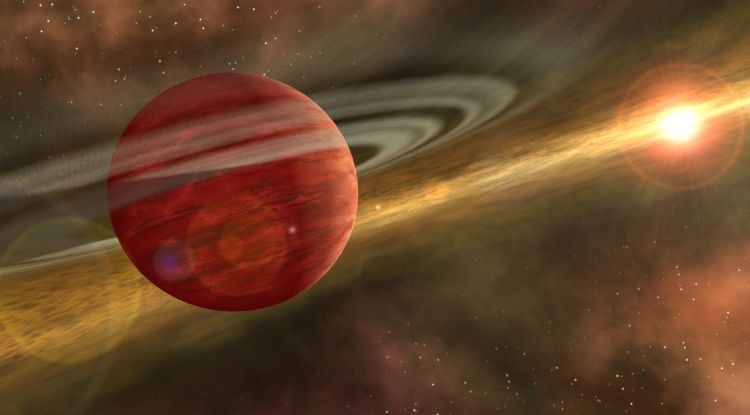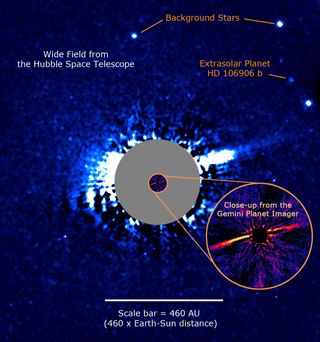Alien Planet May Have Kicked Its Neighbor Into the Sticks

A planet found at an extreme distance from its parent star may have been kicked out by a fellow planet.
Planet HD 106906b orbits 16 times as far from its parent star as Pluto lies from the sun. A new study of the far-flung alien planet reveals what appears to be a lopsided comet belt surrounding its parent star — a finding scientists say indicates a history of violence in the early planetary system.
"Since HD 106906b is very massive, the most likely culprit is another massive planet in the system that gravitationally jostled HD 106906b from its original orbit," Paul Kalas, an adjunct professor of astronomy at the University of California, Berkeley, told Space.com by email. [The Strangest Alien Planets (Gallery)]
Kalas and his team used the Gemini Planet Imager (GPI) in Chile and NASA's Hubble Space Telescope to identify the comet belt. He presented the results earlier this month at the American Astronomical Society's Extreme Solar Systems III conference in Hawaii.
Other possible explanations for HD 106906b's distant orbit include a disruptive interaction with a passing star, according to Kalas.
"If we find another planet, HD 106906c, then we could be more specific about the history of the system," Kalas said.
Kicked out
After a star collapses, planets form from the remaining disk of gas and dust around it. But the distant location of the enormous planet, which is about 11 times as massive as Jupiter, led to speculation that a different process could be responsible. When the planet was discovered last year, some scientists suggested that it might have formed like a star, from its own disk of debris.
Get the Space.com Newsletter
Breaking space news, the latest updates on rocket launches, skywatching events and more!
Intrigued by the strange system, Kalas and his team decided to search for other large planets in the area, using GPI. Instead, they found a massive disk of dust and rocks roughly the width of the solar system's cometary reservoir, the Kuiper Belt, orbiting the star. According to Kalas, the clean-swept interior of the disk suggests that planets formed within it.
The team searched for another large planet near the parent star, but found nothing outside of a Uranus-size orbit.
Hubble telescope images of the star taken previously revealed that the disk of material is even wider than shown by GPI, the new study shows. Rather than being uniform, the belt is lopsided, suggesting that something stirred things up around the star.
Study co-author Ruth Murray-Clay, an assistant professor of physics at the University of California, Santa Barbara, told Space.com that the planet itself is too small to produce such a pronounced flaring without disrupting the thin disk along the way.
"That sort of structure could have been produced by another star that passed by the system in the past," she said.
A passing star also could have played a role in stretching the planet's distant orbit, the study said.
When the planet was booted out of the system, it may have grabbed up material as it passed through the cometary belt, picking up its own disk of debris, the researchers said. Follow-up studies of the system should reveal the presence of such a ring around the planet, they said.
But whether the planet will continue to circle its sun is still uncertain.
"These results are so new, we do not know if the planet is on a bound orbit," Kalas said.
The original discovery of the objects showed that the planet is moving in the same direction, and at the same speed, as the parent star, proving that it is not a background object. If scientists can confirm that the planet still orbits its parent star, it would have the most distant orbit of any known exoplanet.
"Now that we've shown the system is quite interesting because of the disturbed dust disk, there will be a renewed motivation to measure the position of the planet and star over time, and thereby estimate the orbit," Kalas said.
The new results were published in The Astrophysical Journal.

A tight-knit pair
During the question-and-answer session at the conference, Anne-Marie Lagrange, Senior Astronomer of France's National Center for Scientific Research, revealed another surprise about the system: that the host star is not one but two stars orbiting each other at less than half of Earth's distance from the sun. The pair of stars may have influenced the planet's journey in a way that a single star could not, said Lagrange, who is not part of Kalas' team. Her research has been accepted for publication in the journal Astronomy & Astrophysics.
"There is a slight possibility that the planet formed closer to the star, beyond the ice line, and then moved down to within the chaotic zone of the binary, and was then ejected by one of the two binary components, after one or several close encounters," Lagrange said.
Murray-Clay agreed that the binary system could have played a role in kicking out the planet.
"Massive planets like HD 106906b are more easily ejected from a binary star system than from single star systems," she said. "Though we don't have direct evidence that the binary star helped eject this particular planet, it's a reasonable guess."
At the same time, the binary system does not discount the potential for another planet orbiting the two stars. Murray-Clay pointed out that the tight binary stars are too close to generate the inner hole in the ring structure identified by GPI.
"An additional massive body like another planet is required to explain the system," she said.

Dynamical upheaval in action
HD 106906b is a young planet, only about 13 million years old (compared to the Earth's 4.5-billion-year age). Because of its youth, astronomers were able to capture a near-infrared image of the planet by direct imaging.
"Direct imaging of exoplanets is accomplished in the near-infrared because young planets are still quite warm," Kalas said. "What we see in direct images is the heat emitted from such planets, not reflected light."
The more massive a planet is, the longer it takes to cool off. Kalas said the giant world may continue to radiate heat into space for billions of years.
The GPI Exoplanet Survey is targeting 600 young stars, all less than 100 million years old, to get a glimpse of how planetary systems evolve over time and to provide hints about how Earth's solar system evolved.
"The wonderful thing about direct imaging is that we can image exoplanets when they are young — we can find out where they were born and how they evolve," Kalas said.
With HD 106906b, the team can understand some of the dynamics that the early solar system may have gone through.
"I am excited about this system — we're seeing dynamic upheaval in action," Murray-Clay said.
Follow Nola Taylor Redd on Twitter @NolaTRedd or Google+. Follow us at @Spacedotcom, Facebook or Google+. Originally published on Space.com.
Join our Space Forums to keep talking space on the latest missions, night sky and more! And if you have a news tip, correction or comment, let us know at: community@space.com.

Nola Taylor Tillman is a contributing writer for Space.com. She loves all things space and astronomy-related, and enjoys the opportunity to learn more. She has a Bachelor’s degree in English and Astrophysics from Agnes Scott college and served as an intern at Sky & Telescope magazine. In her free time, she homeschools her four children. Follow her on Twitter at @NolaTRedd











